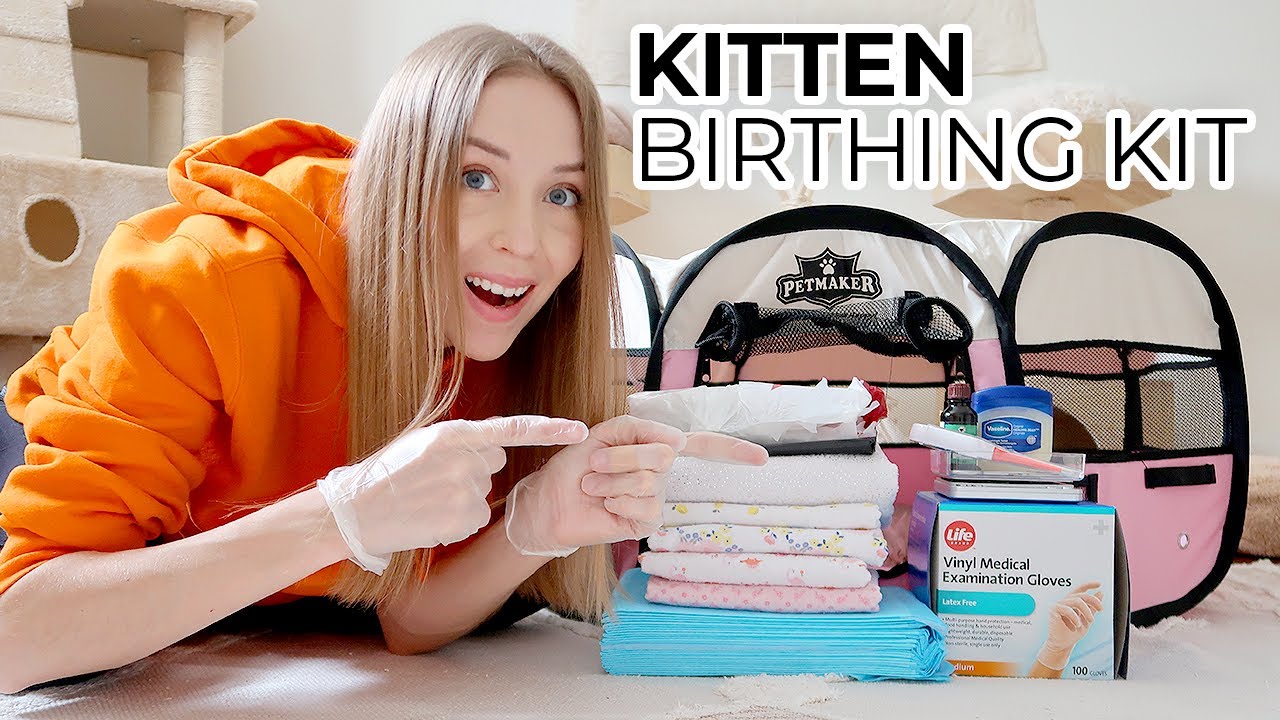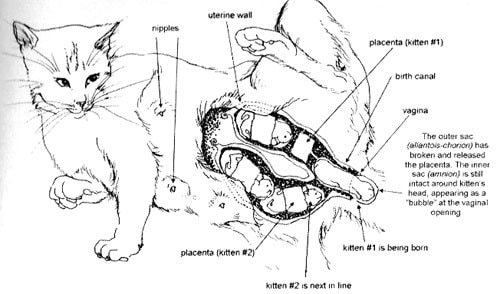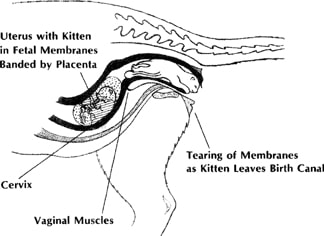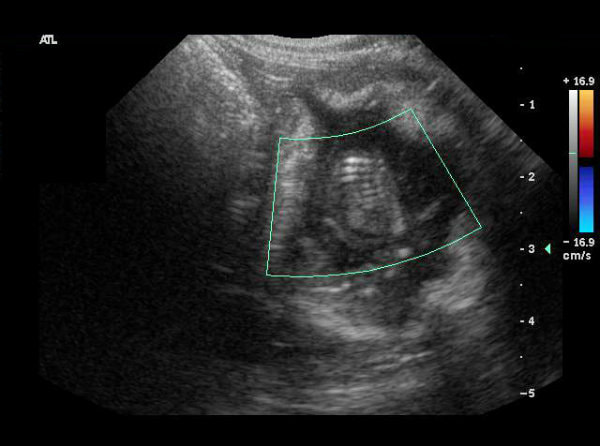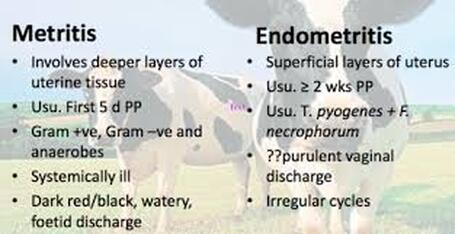Labor

SIGNS OF IMPENDING LABOR: 1st STAGE
- Temperature drop due to decrease in progesterone – 12 hours
- Restlessness, vocalizing, pacing, panting, & excessive vulva cleaning: 2-24hrs
- Nesting behavior starts – 1 to 2 days before
- "Settling in" nesting, being inside Birthing Box – few hours before birth
- Mucous Plug lost - 2 to 24 hours
- Queens typically stop eating 24 hours before birth
BIRTHING SUITE SETUP:
I highly recommend that for the last week or two before the due date that you seclude your pregnant Queen to a small area, such as a walk-in closet, to control the environment. The Birthing Suite should have some important elements:
I highly recommend that for the last week or two before the due date that you seclude your pregnant Queen to a small area, such as a walk-in closet, to control the environment. The Birthing Suite should have some important elements:
- Keep the area secluded and small, all areas inside are safe for her to give birth
- 80-83 degrees! Use a space heater and a temperature sensor to achieve this important feature!
- Warm mist humidifier. Dehydration from dry air and papery-thin skin is a real concern for newborns.
- Camera! Can't emphasize this enough. Allows you to monitor the Queen so you don't miss out on the Labor.
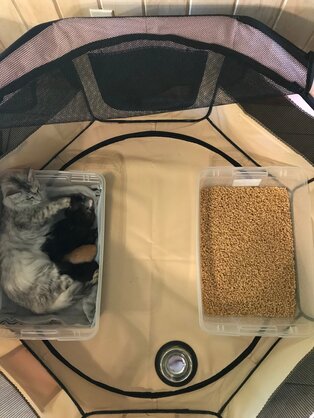
-
- BIRTHING BOX:
- I use a Tupperwares container with the bottom the size of a pillow, the plastic is easy to clean and reuse. There is a hole cut into the side to allow for entry/exit. I line the bottom with 1" memory foam that is wrapped in plastic for easy cleaning and reuse. The plastic encased memory foam is then placed inside a pillowcase that opens from the middle on the back end, this way kittens can't get trapped inside the pillowcase. I also include a heating pad between the pillowcase and memory foam, set always on to setting 1-2. Kittens can die of hypothermia very easily or get sick from being cold.
BIRTHING KIT:
You should have a container setup at all times with all the necessary equipment to assist a Queen in labor. This is what I have in mine:
You should have a container setup at all times with all the necessary equipment to assist a Queen in labor. This is what I have in mine:
|
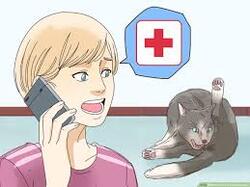
PREVENTING LABOR COMPLICATIONS:
Cats are not designed to sustain labor for long periods of time. The biggest reason for C-sections are caused by long labor and unproductive contractions. The biggest reason for fetal death during labor is prolonged labor. Once a placenta detaches from the uterine wall, oxygen is cut off and the clock starts ticking to get them out or risk death. For these reasons, the best way to prevent complications is to make labor as productive and short as possible. While cats are capable of arresting labor for long periods of time, even giving birth over 2 days, it does increase the risk of fetal death. There are many things you can do to help.
Cats are not designed to sustain labor for long periods of time. The biggest reason for C-sections are caused by long labor and unproductive contractions. The biggest reason for fetal death during labor is prolonged labor. Once a placenta detaches from the uterine wall, oxygen is cut off and the clock starts ticking to get them out or risk death. For these reasons, the best way to prevent complications is to make labor as productive and short as possible. While cats are capable of arresting labor for long periods of time, even giving birth over 2 days, it does increase the risk of fetal death. There are many things you can do to help.
- Sub-cutaneous fluids! If given (120mL) daily for the 3 days before labor and at the onset of labor can greatly increase the effectiveness of labor. Cats have a low-thirst drive already and pregnant cats have a higher need then ever to supply amniotic fluid to many fetuses. Supplying extra fluid allows muscles to sustain contractions with the best efficiency.
- Calcium! Extremely important role in muscle contractions. If calcium stores deplete over the course of prolonged labor it can cause muscles to fatigue quicker and result in weaker and weaker ineffective contractions. To prevent this, give Calcium paste to a Queen in labor at the onset of labor and after each newborn is birthed.
- High-Calorie gel! There are many on the market and any will do but this will help supply the energy needed to sustain labor especially in light of the fact most queens stop eating 24 hours before the start.
- Oxytocin! A very powerful hormone to give contractions, should never be used to start labor as due dates can always be off. Once labor has already begun there are many cases to use Oxy: (0.25mL, minimal 60min between shots & no more than 3x in 24 hrs)
- To start labor back up if labor has arrested for too long (>6-12 hrs, case by case determination).
- If a kitten is stuck, known to be in the birth canal but taking too long (>4 min) to come out, I use Oxy to help push the kitten out
- At the end of labor, to ensure there are no more kittens/afterbirth left & also to help clear out/shrink the uterus.
- Day after labor, used to help with milk production.
|
HARD LABOR: 2ND STAGE
In the second stage of labor, contractions become stronger and more visible and you may note a small amount of clear, tan or blood-tinged vaginal discharge. Cats have 2 Uterine Horns that have kittens lined up in each one. Through contractions, the placenta will detach from the uterine wall and move down the horn. I often find that kittens will be born 2 at a time, one from each horn, followed by a period of rest. Note that it is perfectly normal for kittens to be born either head first or back-end first. Either way; according to Canine and Feline Reproduction, by Margaret Kustritz; once contractions are seen, a kitten should be born within four hours. If your cat’s pushing hard, a kitten should be passed within 30 minutes. |
EXPULSION OF PLACENTA: 3RD STAGE
Third stage labor involves the expulsion of the placenta. Again, you need to be aware. Count to be sure your cat delivers the same number of placentas as she does kittens. Then, feel free to take away the placentas and dispose of them.
Third stage labor involves the expulsion of the placenta. Again, you need to be aware. Count to be sure your cat delivers the same number of placentas as she does kittens. Then, feel free to take away the placentas and dispose of them.
|
HELP! MY KITTEN IS STUCK!
There is a kitten in the birth canal playing the Peek-a-Boo but isn't coming out and the minutes are ticking by. I wait no more than 4 minutes before I start to take action. Mom is getting a shot of Oxytocin (0.25mL) and I am physically holding up the mom vertically to allow gravity to help. Mom isn't thrilled but I support her as I keep her vertical and as soon as I can get any extra exposed skin, preferably the scruff on the back of the neck or the torso, I gently pull the kitten out. Don't ever pull on a limb or a head because you can dislocate and injure the kitten. |
MEDICAL INTERVENTION??
Dystocia (or difficulty giving birth) can be a serious problem for both mother and kittens. Once you know how a normal birth progresses, any deviation from that norm is worthy of a phone call to your veterinarian or an emergency clinic depending on the time of day. It’s far better to contact your veterinarian and to be told that everything is okay than it is to not call and let a problem get worse. It is advisable, however, that you call someone first because it is not in your cat’s best interest to disturb her or to disrupt her delivery by rushing her off to the hospital unnecessarily.
In fact, at one of your cat’s prenatal checkups with your veterinarian, be sure to ask when/why you should make contact. In general, though, consider calling if:
Dystocia (or difficulty giving birth) can be a serious problem for both mother and kittens. Once you know how a normal birth progresses, any deviation from that norm is worthy of a phone call to your veterinarian or an emergency clinic depending on the time of day. It’s far better to contact your veterinarian and to be told that everything is okay than it is to not call and let a problem get worse. It is advisable, however, that you call someone first because it is not in your cat’s best interest to disturb her or to disrupt her delivery by rushing her off to the hospital unnecessarily.
In fact, at one of your cat’s prenatal checkups with your veterinarian, be sure to ask when/why you should make contact. In general, though, consider calling if:
- Your cat goes beyond her proposed due date without going into labor
- You do not see evidence that Stage 1 labor has started 24-36 hours after the drop in rectal temperature mentioned above
- Stage 1 labor has not progressed to Stage 2 labor after 24 hours
- The first kitten has not been delivered after 1 hour of active hard labor
- It has been more than two hours without the appearance of another kitten (personally, I wait up to 6 hours)
- Vaginal discharge is purulent or frankly hemorrhagic
- Your cat is in apparent distress or pain or seems ill or disoriented
- Kittens are stillborn or are alive but seem weak or not normal.
- You know that there are more kittens on the way but your cat appears to be exhausted and labor seems to have stopped. (If you had Xrays taken late in pregnancy to count the kittens, that information will now be extremely valuable.)
PREVENTING NEWBORN COMPLICATIONS:
- At birth, clear the airway as soon as possible. Break the sac, if there is one, and wipe away all fluid with a paper towel. Use your mouth or a Mucous Trap to clear any more fluid. Any inhalation of fluid, even before birth, can cause pneumonia later.
- If a kitten is born not moving, do not assume it is a still born. Many have been saved simply by eliminating the fluid in the lungs and breathing life back into the neonate. Upon resuscitation, giving extra oxygen is very beneficial via an Oxygenator machine.
- A shot of Penicillin (dual short & long acting) at birth can prevent milk-inhaled or meconium/amniotic-inhaled pneumonia. The dual action allows the Penicillin to work for 48 hrs and injecting it bypasses the immature digestive system.
- Clean the umbilical cord at birth with Iodine or Vetericyn Super 7 Ultra Naval Spray to prevent any infection
- Of those kittens that don't make it after birth, 80% succumb within the first 5 days & 20% within the first 2 weeks. Of those that do succumb, the biggest reasons are:
- Hypothermia: caused when they move away from mom. Prevention tip: heat pad & heated space (80-83 degrees)
- Dehydration: caused by dry air & lack of nursing. Prevention tip: observe nursing, supplement if needed. Warm-mist humidifier.
- Infection: caused by milk/meconium inhalation, umbilical cord contamination, etc. Prevention tip: anaphylactic antibiotic
- Accidental squishing: happens more often then you think! Prevention tip: Camera, keep an eye out all the time for first 5 days
- Genetic defects: Cleft palate, tubal defects Prevention tip: It's all about Prenatal care. Check out supplements Breeder's Edge.
|
|
|
|
|
|
Possible Post-Birth Complications
|
Retention of Fetal Membranes
Occasionally a cat may fail to pass fetal membranes after birthing is complete, and they will decompose within her uterus. Signs:
Treatment:
Prevention: A final shot of Oxytocin (0.25mL) at the end of Labor will help expel any remaining kittens/placentas |
|
Metritis or Endometritis
Metritis and endometritis are different types of inflammation of the uterus that usually occur within three days of parturition. Signs:
|

Mastitis
Mastitis or inflammation of a mammary gland sometimes occurs during early lactation. Most apparent when kittens do not gain weight as they should. This is because the infection blocks the mother’s milk from flowing properly.
Signs:
Treatment:
1. Antibiotics.
Because mastitis is caused by bacteria which results in an infection, antibiotics are often necessary. Probiotics, pain medicine, and anti-inflammatory prescriptions can also help treat the infection and associated symptoms.
2. Clean the area clean. Wipe your cat’s teat with a warm, damp cloth and change her bedding regularly. This will help the teat heal and reduce the likelihood of another infection developing.
3. Try a natural compression.
Preventing Mastitis:
Clean is key too preventing mastitis in nursing cats. Change your cat’s bedding frequently and keep the surrounding area clean. If kittens track into urine or feces, clean their paws with warm damp wipes. Keep an eye on if the kittens are rotating between teats. If one teat is ignored it may be developing mastitis or more prone to develop mastitis.
Mastitis or inflammation of a mammary gland sometimes occurs during early lactation. Most apparent when kittens do not gain weight as they should. This is because the infection blocks the mother’s milk from flowing properly.
Signs:
- Redness of the breast
- A swollen breast
- Discharge of the nipple
- Pain when touched
- Purple coloration (in severe cases)
- Ulcers (in severe cases)
- Blood or pus from the nipple (in severe cases)
Treatment:
1. Antibiotics.
Because mastitis is caused by bacteria which results in an infection, antibiotics are often necessary. Probiotics, pain medicine, and anti-inflammatory prescriptions can also help treat the infection and associated symptoms.
2. Clean the area clean. Wipe your cat’s teat with a warm, damp cloth and change her bedding regularly. This will help the teat heal and reduce the likelihood of another infection developing.
3. Try a natural compression.
Preventing Mastitis:
Clean is key too preventing mastitis in nursing cats. Change your cat’s bedding frequently and keep the surrounding area clean. If kittens track into urine or feces, clean their paws with warm damp wipes. Keep an eye on if the kittens are rotating between teats. If one teat is ignored it may be developing mastitis or more prone to develop mastitis.
|
Eclampsia or Milk Fever
In cats, milk fever (also called eclampsia or lactation tetany) may occur 2-6 weeks after the birth of kittens and is due to a sudden drop in the amount of calcium circulating in the bloodstream, associated with the heavy demands of milk production. The affected cat is usually nursing a large litter. Signs:
Treatment:
Any affected cat should only be allowed to rear a small number of kittens at any subsequent litter. Since lactation tetany often recurs with subsequent litters, it should factor into any decisions about breeding an affected queen. Prevention: A good Postnatal Supplment, like Breeder's Edge Oxy Momma, will help to give the calcium and other nutrients needed. Start weaning kittens at 4 weeks to help take the demand off mom. |
